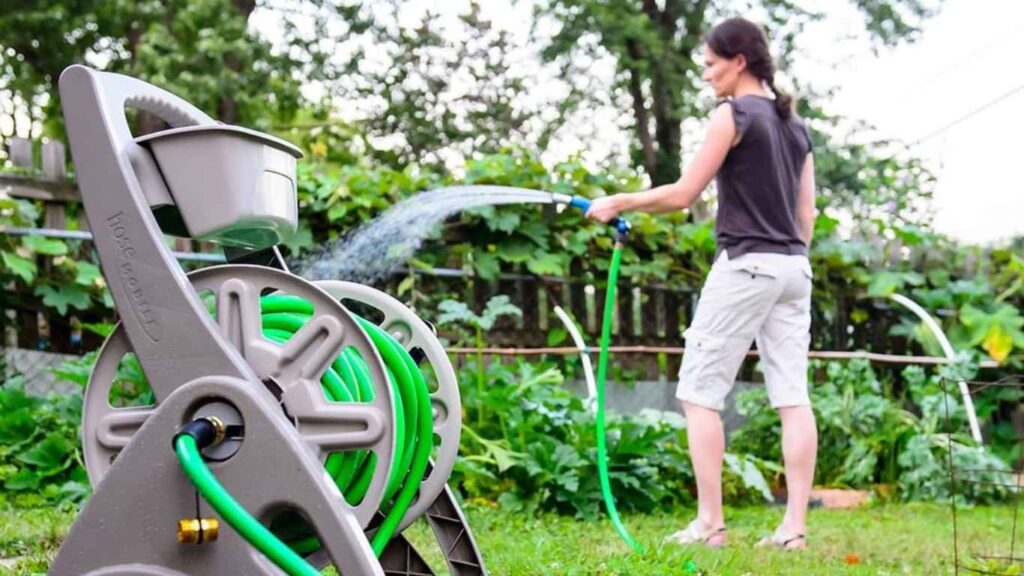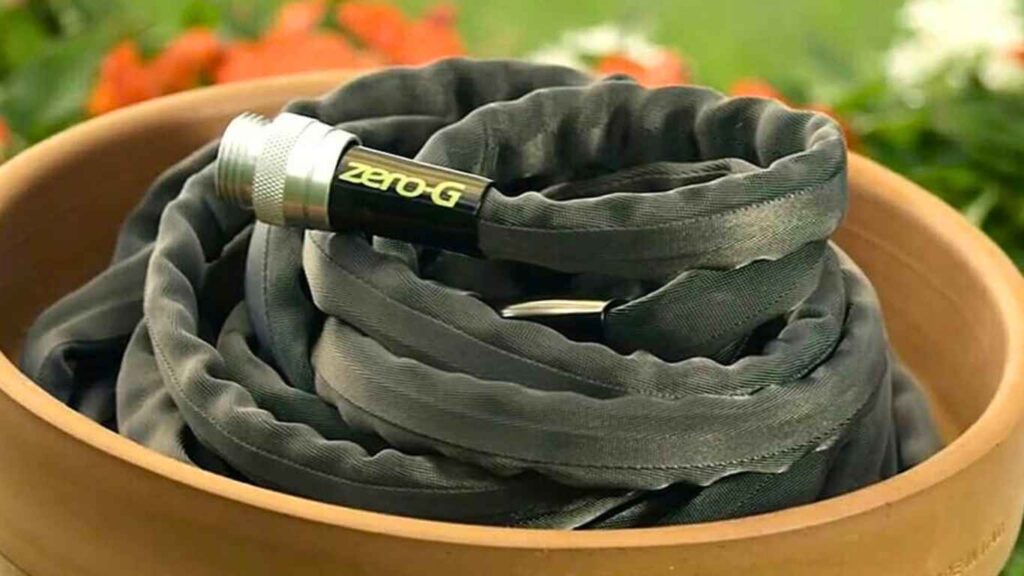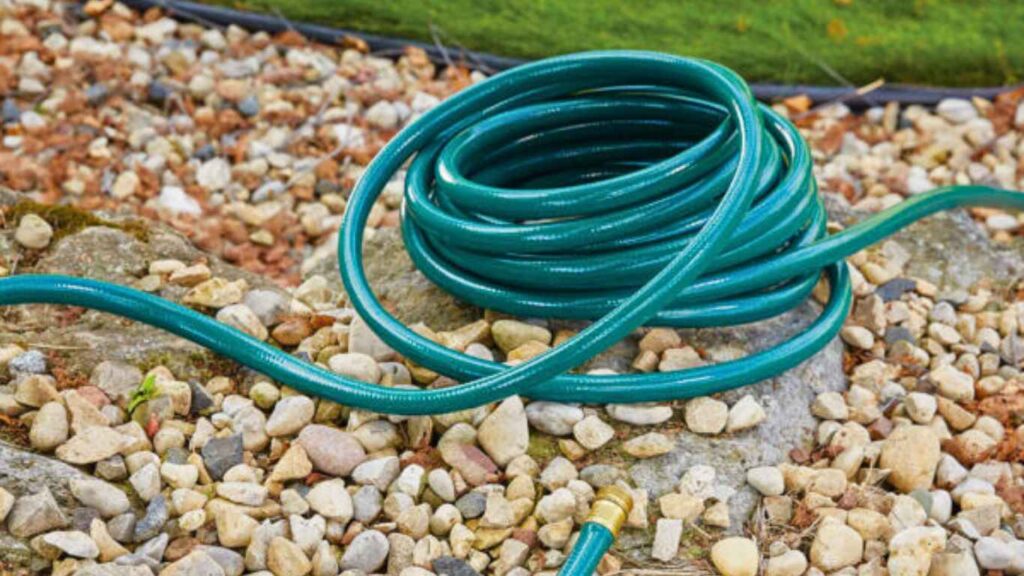Finding the best garden hoses is essential to any gardener’s toolkit. Watering your lawn and plants can be easy and time-consuming with the right type and length of hose.
But don’t worry!
We’ve got you covered. This blog post will explore seven of the best garden hoses for watering your lawn and plants.
Let’s get started!
7 Best Garden Hoses for Watering Your Lawn and Plants

If you’re like most homeowners, watering your lawn and plants is one of the most regular tasks you do in your garden. But, with summer heat and humidity looming, choosing the perfect garden hose is essential.
Here are seven of the best garden hoses for watering your lawn and plants:
Flexzilla Garden Hose

If you’re looking for a flexible and reliable garden hose, the Flexzilla Garden Hose is an excellent option. This hose is made of a durable, lightweight, and pliable material designed to provide long-lasting performance.
It’s crush-resistant and kink-resistant with a unique reinforced outer layer that helps ensure consistent water flow. The hose also has an ergonomic grip with a lay-flat design that makes it easier to coil and store when not in use.
Plus, this garden hose has a lightweight design that makes it easy to carry around your garden or yard.
Swan Soft & Supple Garden Hose

For those looking for a quality garden hose that will last season after season, the Swan Soft & Supple Garden Hose is a perfect choice. Its robust construction features a triple-layer latex core with a specially reinforced jacket to provide strength and durability.
This hose is available in several sizes, ranging from 25 to 100 feet, so that you can find the perfect length for your garden. Additionally, this hose is incredibly lightweight and flexible, making it easy to maneuver and store away when not in use.
And with its soft and supple texture, it’s also gentle on your plants, ensuring they won’t be damaged during watering.
Teknor Apex NeverKink 8615-50 Garden Hose

For those looking for a reliable garden hose, the Teknor Apex NeverKink 8615-50 is an ideal choice. This hose is made with a patented anti-kink technology that ensures your hose will never kink or tangle.
The NeverKink 8615-50 is constructed from high-quality, lead-free aluminum and vinyl. These Make it incredibly durable and able to withstand harsh conditions. The brass couplings are leak-proof, rust-resistant, and have a heavy-duty grip for maximum water flow. Also, it has a power coil that prevents kinking and twisting at the faucet connection.
The power coil reduces strain on the hose and maximizes the water pressure. Additionally, this hose is weather resistant and can handle extreme hot and cold temperatures.
With its versatile design and superior construction, the Teknor Apex NeverKink 8615-50 is an excellent choice for all your watering needs.
Gilmour Flexogen Heavy-Duty Garden Hose

This hose is a heavy-duty material that can withstand extreme temperatures and weather conditions. It is designed to be highly flexible, making it easy to maneuver in tight spaces. Plus, the hose is available in various sizes, so you can choose the one that best fits your needs.
This garden hose has a leak-proof, crush-resistant brass coupling that ensures a tight seal when connected to your water source. The Gilmour Flexogen Heavy Duty Garden Hose has a built-in strain relief feature that prevents kinking and tangling.
With its reliable performance and easy maneuverability, you can’t go wrong with this hose!
Dramm ColorStorm Rubber Hose

If you are looking for a garden hose that is both durable and colorful, look no further than the Dramm ColorStorm Rubber Hose. This garden hose is made of rigid rubber material that can withstand any outdoor elements. Also, it has a bright and cheerful hue.
The bright colors of this hose also make it easier to identify. So you don’t have to worry about accidentally grabbing the wrong hose when watering your plants or lawn.
Additionally, it is built with brass couplings and a leak-proof seal that prevents water from seeping. It means you can rest assured that your garden watering needs will be taken care of.
Miracle-Gro UltraLight Flexible Garden Hose

Miracle-Gro UltraLight Flexible Garden Hose stands out from the crowd regarding garden hoses.
This ultra-lightweight hose weighs only 3.7 lbs, making it one of the lightest on the market. Its flexibility makes it easy to coil and store, and its ability to bend without kinking is a significant plus. This hose is also resistant to abrasions and tears, ensuring it won’t be easily damaged.
It can handle cold temperatures up to 45°F so you can use it all year round with no worries. The heavy-duty design allows for more significant water pressure and flow. It makes your gardening and landscaping tasks more accessible than ever.
Whether you need a lightweight hose for regular use or occasional projects, Miracle-Gro UltraLight Flexible Garden Hose covers you.
Pocket Hose Top Brass Bullet Connector

The Pocket Hose Top Brass Bullet Connector is an excellent option for gardeners looking for a convenient way to water their lawns and plants. This hose features a unique, bullet-shaped connector that allows you to quickly and easily attach the hose to your faucet without any tools.
The brass construction makes this hose durable and able to withstand heavy use, while the lightweight design makes it easy to maneuver and transport. The hose also comes with an 8-pattern sprayer for various watering needs. Additionally, the hose can expand up to three times its original length when filled with water.
With the Pocket Hose Top Brass Bullet Connector, you can enjoy a hassle-free way to keep your lawn and plants healthy and hydrated.
Conclusion
A suitable garden hose is essential when keeping your lawn and plants healthy and green.
The proper garden hose can provide a steady stream of water to your plants without putting too much strain on your arms or wallet. Whether you’re looking for a lightweight, flexible hose or a heavy-duty option that won’t kink, there’s a perfect garden hose for every garden out there. We hope this guide has helped you find the best garden hose.
With the correct hose, you can keep your plants looking their best all season long.













![No Win No Fee Lawyers: The Hidden Truth About Settlement Cuts Legal representation through no win no fee lawyers gives clients a way to fight cases without paying anything upfront. Many clients don't know that these services take a big chunk of money after winning the case. Lawyers usually take 25% to 40% of what you win as their contingency fee. The amount lawyers take from settlements can add up fast. A $100,000 settlement means your attorney gets $30,000 if they charge a 30% fee after winning your case. Your solicitor's cut might be £10,000 from a £30,000 compensation award, based on your agreement percentage. This payment model stays pretty much the same for no win no fee lawyers in different places, though percentages can change. This piece breaks down what you need to know about contingency fee deals. You'll learn about standard fee ranges, extra costs beyond the basic fee, and times when this payment setup might not work in your favor. Smart clients should think over these money matters before signing up with a lawyer to make better choices about their legal help. What No-Win No-Fee Really Means Image Source: Express Legal Funding A no-win no-fee arrangement, also called a Conditional Fee Agreement, changes the way people get legal help. This payment approach removes the need to pay legal fees upfront and creates a partnership between clients and their attorneys. How contingency fees work No-win no-fee agreements are based on contingency fees. Lawyers get paid only when they win compensation for their clients. Most lawyers take between 25% and 40% of the final amount, based on how complex the case is and where it's filed. Lawyers take their cut after winning the case. To name just one example, see a case where a lawyer wins £30,000 in compensation with a 33% fee - they would receive £10,000. On top of that, some law firms use sliding scales where they charge less for quick settlements and more if the case goes to trial. The law requires a written agreement before any work starts. This paperwork spells out the lawyer's percentage, what costs you'll need to cover, and other key details. What happens if you lose the case The meaning behind "no-win no-fee" is clear - losing your case means you won't pay your lawyer anything. All the same, you should know about a few money-related details. You won't owe your lawyer when you lose, but some deals might make you pay for court fees, expert witnesses, or other case expenses. The other side could also ask you to pay their legal costs. Many lawyers suggest getting "After Event" insurance to protect their clients. These policies cover any costs if you lose your case, which makes the no-win no-fee setup much safer. Why lawyers offer this model Lawyers want to make legal help available to more people, so they offer these payment plans. This setup helps people who don't have much money take legal action when they have valid claims. The payment structure motivates lawyers to work hard. They only get paid by winning cases, which pushes them to get the best results possible. Lawyers carefully assess each case before taking it on a no-win no-fee basis. They usually accept cases that have a good chance of winning, since they put in lots of time and resources without any guaranteed payment. The Real Cost: How Much Do Lawyers Take from a Settlement Image Source: Greiner Law Corp. The true cost of no-win no-fee legal representation becomes clear once we look at contingency fees. Many clients feel surprised to see a big chunk of their settlement checks going to their attorney's fees. Typical percentage ranges (25%–40%) No win no fee lawyers typically ask for 25% to 40% of the total settlement amount. Personal injury attorneys usually take 33.3% (one-third) of the awarded compensation[101]. Lawyers and clients agree on this percentage before any work starts on the case. Several factors shape the final percentage. Your chances of winning, case complexity, and the work to be done play key roles in determining the attorney's cut. Some areas have laws that cap the maximum contingency fees for specific types of cases. Sliding scale based on case complexity Law firms often use a tiered fee system that changes with the case stage and complexity. This scale rewards quick settlements while paying attorneys fairly if more work becomes needed. The fee might start at 30% if the case settles before lawsuit filing. This number could climb to 35% after filing or reach 40% if the case goes to trial. Law firms often group cases by complexity: 10%-20%: Simple cases with straightforward settlements 25%-35%: Typical personal injury cases 35% and above: Complex cases requiring extensive resources Examples of payout breakdowns These ground examples show how fees affect settlements: A $15,000 settlement with a 33.3% contingency fee.pdf) puts $5,000 in the attorney's pocket, leaving $10,000 for the client. Similarly, from a $100,000 settlement with a 33% fee, the attorney gets $33,000 while the client receives $67,000[102]. Complex cases tell a different story. A $100,000 settlement with a 30% fee plus $5,000 in extra costs leaves $65,000 for the client after all deductions. These fees substantially change the client's final payout. Hidden Costs You Might Not Expect Image Source: Nelson Personal Injury Lawyers Beyond percentage-based fees, clients often feel surprised by extra costs that can reduce their final compensation by a lot. These hidden costs show up in the fine print of no-win no-fee agreements. You should think over these details before signing. Court filing and expert witness fees Legal proceedings come with unavoidable court filing fees. These charges differ by jurisdiction. They usually range from $30 for small claims to several hundred dollars for complex civil lawsuits. Expert witnesses can be expensive, with hourly rates ranging from $150 to $1,000 based on their credentials and testimony complexity. Expert witnesses charge more for court appearances than consultation work because of added pressure and prep time. Clients might still need to pay experts for their prep work even if the case settles before trial. Medical report and investigation costs Medical documentation is a vital part of many legal claims. These costs include fees to release medical records, create specialized reports, and prepare documents. Investigation costs cover evidence gathering, police reports, witness interviews, and other fact-finding work needed to build a strong case. Of course, some firms say they'll cover these expenses upfront, but clients don't completely avoid these costs. When these costs are deducted from your compensation Law firms take these expenses from the settlement amount before they calculate their percentage fee, though each firm handles this differently. Some lawyers subtract these costs after figuring out their contingency fee, which changes how much money clients end up with. Most firms pay case-related costs during the process and get their money back from the settlement. The defendant usually pays most simple legal costs and disbursements in successful cases, but not always everything. Insurance protects clients from costs in unsuccessful claims at many law firms, but this protection isn't guaranteed. Clients should review their agreements carefully since they might still need to pay specific expenses even if they lose their case. When No-Win No-Fee Might Not Be the Best Option Contingency fee arrangements give many people access to justice. However, this payment model doesn't always work in a client's best interests. Knowing these limitations helps clients make better decisions about their legal representation. Cases with unclear liability Lawyer no win no fee arrangements work best in cases where fault is clear. We assessed the probability of success before taking contingency cases. Lawyers might turn down cases if there isn't enough evidence of the other party's negligence or if liability isn't certain. Cases with multiple responsible parties create more challenges. The situation gets complicated fast when several parties share liability. Lawyers are less likely to take these cases on contingency. They need to be confident they can prove the other party's negligence before accepting a case. Low-damage or low-payout claims Small claims often don't work well with the contingency model, even with real injuries. Cases that have minimal injuries or limited financial damages might not bring enough compensation to cover legal costs. The potential settlement needs to be big enough to pay for investigations, witness interviews and court fees. Personal injury lawyers often turn down cases where the "compensation potential" is too small. This doesn't mean the claim isn't valid - it just means the economics don't add up for a contingency arrangement. Situations where hourly billing may be better Hourly billing has clear advantages in certain cases. Clients see exactly what they're paying for - every hour worked and task completed. This model works well for cases that need lots of attention but don't have clear financial outcomes. Complex litigation with opposing parties works better with hourly billing and a retainer fee. Clients have more control over their case and don't feel pressured to settle quickly. Cases that need extensive preparation but have uncertain outcomes fit the hourly model better. Lawyers can spend the time needed without worrying about contingency limits. This approach often leads to better representation, especially for complex legal issues that need special expertise. Conclusion Understanding the Full Picture Before You Sign No-win no-fee arrangements offer legal representation without upfront costs. Of course, this seems attractive at first glance. In spite of that, you need to think about how these agreements can affect your final compensation. Legal fees usually range from 25% to 40% of your settlement - but that's just the start. You'll face more deductions like court filing fees, expert witness costs, and charges for medical documentation. What looks like a "free" service ends up taking a big chunk of your compensation to cover legal expenses. These arrangements work best in specific situations - cases with obvious liability, substantial damages, and solid evidence. If you have a low-value claim or complex liability issues, traditional hourly billing might serve you better. Without doubt, you should ask for clear explanations of all possible costs before signing anything. Read the fine print closely, especially when you have to deal with expenses in unsuccessful cases. Ask to see sample settlement breakdowns that show all deductions. This helps you picture what you might actually take home. Your choice to go with a no-win no-fee arrangement depends on your situation. This model helps if you don't have money to pursue valid claims. But if you have a strong case and enough funds, other fee structures might let you keep more of your compensation. Whatever payment model you choose, knowing exactly how much lawyers take from settlements helps you make better decisions. This knowledge lets you approach legal representation with real expectations and better control over your money. FAQs Q1. What percentage of a settlement do no-win no-fee lawyers typically take? No-win no-fee lawyers typically charge between 25% to 40% of the final settlement amount as their contingency fee. The exact percentage often depends on the complexity of the case and the stage at which it is resolved. Q2. Are there any hidden costs in no-win no-fee arrangements? Yes, there can be additional costs beyond the lawyer's percentage fee. These may include court filing fees, expert witness costs, medical report expenses, and investigation costs. These expenses are usually deducted from the settlement amount before or after the lawyer's fee is calculated. Q3. What happens if I lose my case in a no-win no-fee arrangement? If you lose your case, you generally won't have to pay your lawyer's fees. However, you might still be responsible for certain expenses like court costs or the opposing party's legal fees. Many lawyers offer insurance to protect clients from these potential costs in case of an unsuccessful claim. Q4. When might a no-win no-fee arrangement not be the best option? No-win no-fee arrangements may not be ideal for cases with unclear liability, low-value claims, or complex legal issues requiring extensive preparation. In these situations, traditional hourly billing might be more appropriate and potentially more cost-effective for the client. Q5. Can I negotiate the percentage a lawyer takes from my settlement? Yes, the contingency fee percentage is often negotiable. It's typically agreed upon and formalized in writing before the lawyer begins working on your case. Don't hesitate to discuss the fee structure with your lawyer and ask for a detailed breakdown of potential costs and deductions.](https://consumersweek.com/wp-content/uploads/2025/06/No-Win-No-Fee-Lawyers-The-Hidden-Truth-About-Settlement-Cuts-870x570.webp)

